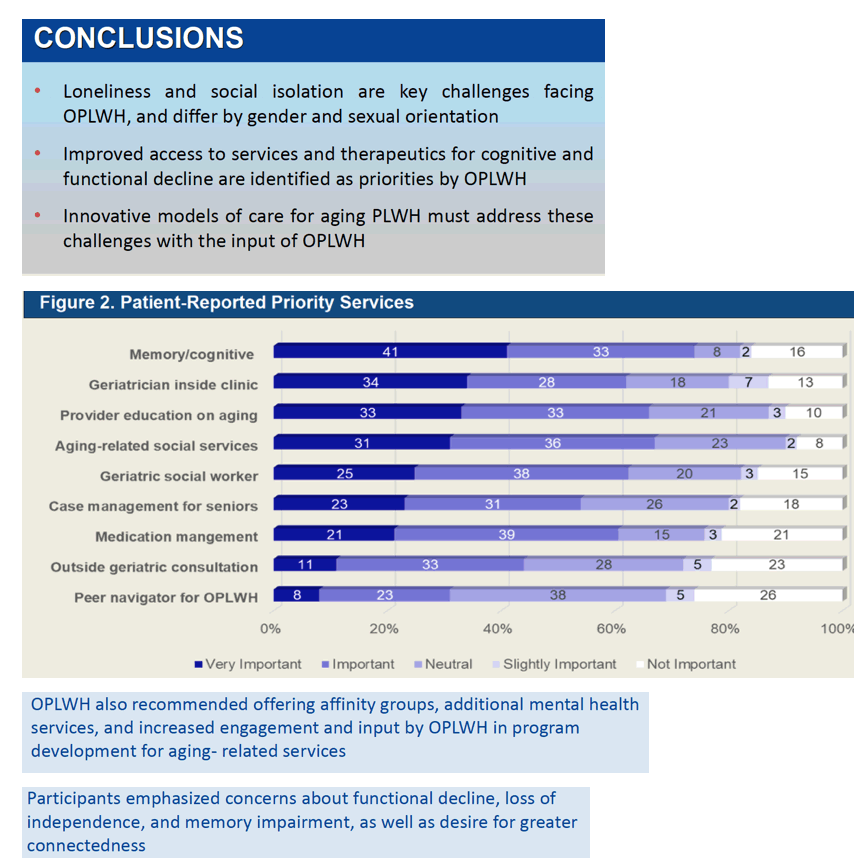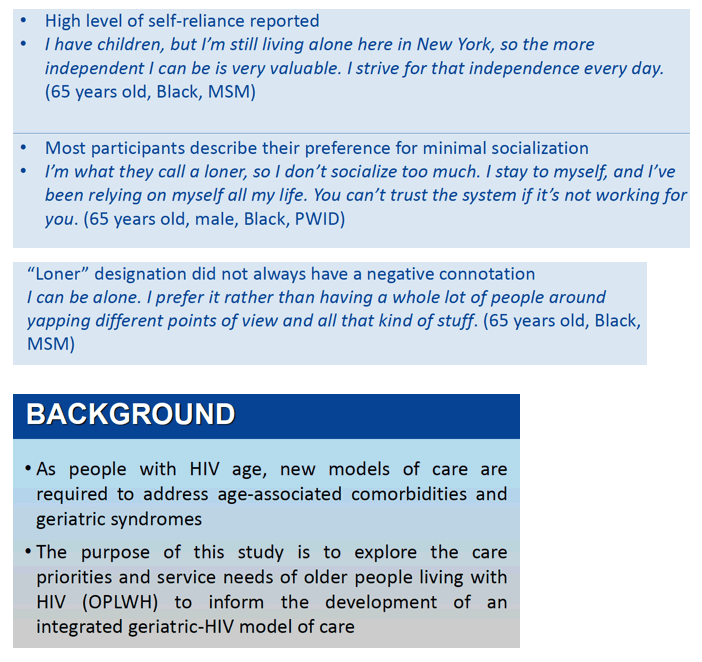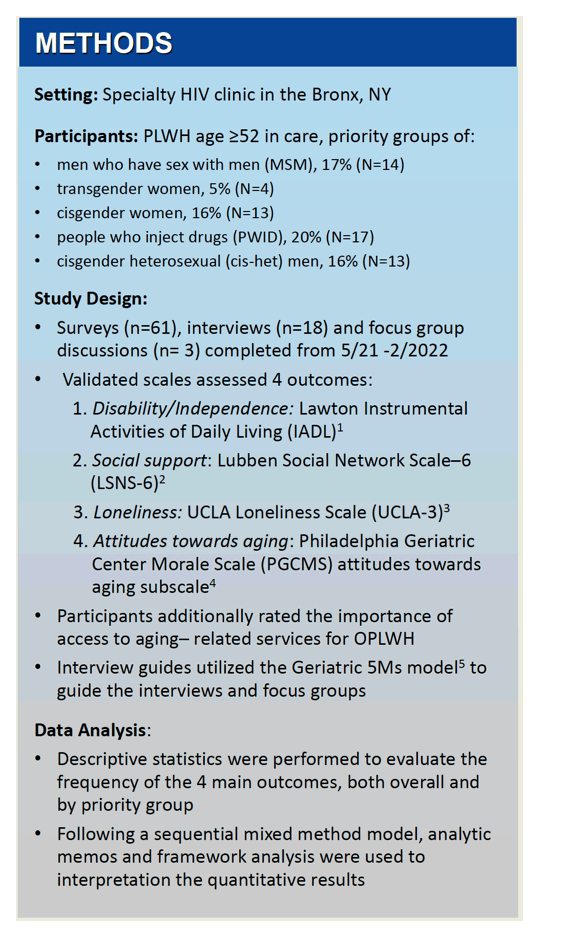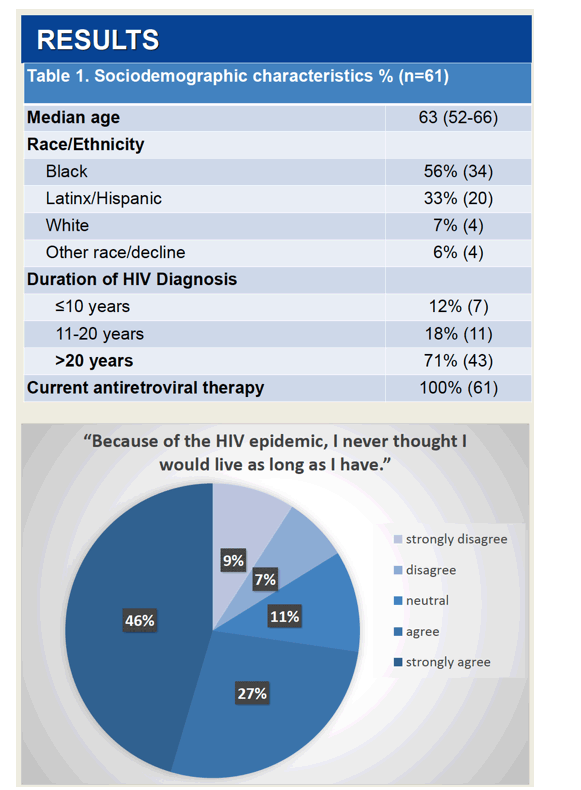 |
 |
 |
| |
Clinical Care Priorities and Service Needs
Among People Aging with HIV in the Bronx, NY
|
| |
| |
Aging Workshop 2022 Oct 14-15
Reported by Jules Levin
Amanda Pierz1, Gabrielle Ryan2, Tonya Taylor3, Wanda Tejada Lizardo1, Chenshu Zhang2, Sergio Rivera Rodriguez1, Michael Bogaisky4, Robert Grossberg5, Hilda Morales5, Barry S. Zingman5, Anjali Sharma2,5
1Department of Community Health and Social Sciences, CUNY Graduate School of Public Health: New York, NY, USA
2Division of General Internal Medicine, Department of Medicine, Montefiore Medical Center: Bronx, NY, USA
3College of Medicine, Division of Infectious Disease Special Treatment and Research (STAR) Program, SUNY Downstate Medical Center: Brooklyn, NY, USA 4Division of Geriatrics, Department of Medicine, Montefiore Medical Center: Bronx, NY, USA
5Division of Infectious Disease, Department of Medicine, Montefiore Medical Center: Bronx, NY, USA


New care models are necessary to address the increasing burden of age-associated comorbidities and geriatric syndromes experienced by the aging population with HIV. This project seeks to describe qualitative and quantitative data collected from older persons living with HIV (OPLWH) on clinical care priorities and service needs, to inform the development of an integrated geriatric-HIV model of care.
Material and Methods: Patient perspectives of PLWH age 60 years and above receiving care in an ambulatory HIV specialty clinic in the Bronx, New York were examined in Spanish and English via 84 telephone surveys, 27 in-depth individual interviews and 3 focus groups conducted online among priority groups of men who have sex with men (MSM), transgender women, cisgender women, people who inject drugs (PWID), and cisgender heterosexual (cis-het) men between 5/2021 to 2/2022.
Results: Median age was 63 years (IQR 62-66), 56% were Black, 33% Hispanic, 7% White, 6% other; participants included 13 MSM, 13 cis-gender women, 4 transgender women, 13 cis-gender heterosexual men, and 17 PWID. All OPLWH were taking ART, 71% were diagnosed with HIV over 20 years ago, and 72% reported that they had not expected to survive as long as they have. Using the Lawton IADL scale, 52% reported some degree of disability, including 30% with disability in one domain; 23% had disability in multiple domains, more commonly occurring among cisgender women, MSM, and PWID. Loneliness was reported by 25% (UCLA-3 score 6-9); 52% were considered socially isolated (Lubben Social Network Scale-6, LSNS-6 score <12), including 32% with marginal family ties (LSLS-6 subscale <6), and 63% with marginal friendship ties. Themes from individual interviews and focus groups emphasized concerns about functional decline, loss of independence, and memory impairment, as well as desire for greater connectedness.
Highest priority services rated by OPLWH included evaluation and management of cognitive impairment, having an on-site geriatrician in the HIV clinic, enhanced provider education on aging, and increased access to aging-related social services.
OPLWH also recommended offering support groups, additional mental health services, and increased engagement and input by OPLWH in program development for aging- related services.
Conclusions: Loneliness, social isolation, and cognitive and functional decline are key challenges facing OPLWH, many of whom had not expected to survive into older age. Models of care for aging PLWH must address these particular challenges with the input of OPLWH to increase access to necessary services and support for the growing numbers of PLWH surviving into older age.






|
| |
|
 |
 |
|
|